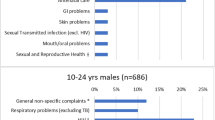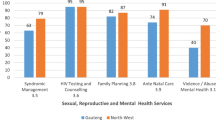Abstract
Objectives
To assess the awareness and utilization of Adolescent Friendly Health Clinic (AFHC) services among school going adolescents (14–19 y) and to explore the forces ‘for’ and ‘against’ the utilization of AFHC services in Puducherry, India.
Methods
This mixed-methods study was conducted in two primary health centres. Record review assessed the utilization of AFHC service. Survey assessed the awareness on AFHC services and self-reported illnesses and their treatment seeking behavior. Group interviews were conducted with adolescent girls, boys and healthcare providers. A summative content analysis was done to organize the ‘for’ and ‘against’ forces for service utilization.
Results
Of the 311 adolescents, less than 50% were aware of the services available at AFHC. Utilization of Weekly Iron and Folic Acid Supplementation was good. Only 2–10% of adolescents consulted the outpatient services of the Primary Health Centre for the treatment of their health problems. The authors found low utilization of AFHC services (15% among girls, zero among boys). One of the reasons for low utilization was poor awareness. Though free sanitary napkins motivated the girls to avail the services, boys considered the AFHC as a girl’s clinic. Healthcare providers suggested that building rapport and trust with adolescents and their parents, involving school teachers and ensuring privacy in the clinic would increase the utilization.
Conclusions
There is a huge gap between the awareness and utilization of AFHC services. The reasons for non-utilization were poor awareness and misconceptions about the clinic. Training of health staffs on communication skills, and supportive supervision could improve the utilization.
Similar content being viewed by others
References
World Health Organization - Adolescents: health risks and solutions [Internet]. WHO. World Health Organization; 2017. Available at: http://www.who.int/mediacentre/factsheets/fs345/en/. Accessed on 30th June 2018.
Registrar General & Census Commissioner I. Adolesecents and youth in India-highlight from census 2011 [Internet]. Available at: http://www.censusindia.gov.in/2011-Documents/PPT_World_Population/Adolescents_and_Youth_in_India_Highlights_from_Census_2011.pptx. Accessed on 2nd July 2018.
World Health Organisation. WHO | Adolescent health [Internet]. WHO. World Health Organization; 2017. Available at: http://www.who.int/topics/adolescent_health/en/. Accessed on 2nd July 2018.
World Health Organization. Global accelerated action for the health of adolescents (AA-HA!) Guidance to support country implementation [Internet]. 2017. Available at: http://apps.who.int/iris/bitstream/handle/10665/255415/9789241512343-eng.pdf;jsessionid=30FC9B9EC28F7A0E482FBE28BA62CF1E?sequence=1. Accessed on 4th July 2018.
Sheehan P, Sweeny K, Rasmussen B, et al. Building the foundations for sustainable development: a case for global investment in the capabilities of adolescents. Lancet. 2017;390:1792–806.
Adolescent Health Division, Ministry of Health and Family Welfare, Government of India. Rashtriya Kishor Swasthya Karyakram - Operational Framework [Internet]. 2014; Available at: http://nhm.gov.in/images/pdf/programmes/RKSK/RKSK_Operational_Framework.pdf. Accessed on 4th July 2018.
Adolescent Health Division, Ministry of Health and Family Welfare, Government of India. Rashtriya Kishor Swasthya Karyakram: strategy handbook [Internet]. 2014; Available at: http://nhm.gov.in/images/pdf/programmes/rksk-strategy-handbook.pdf. Accessed on 4th July 2018.
Santhya KG, Prakash R, Jejeebhoy SJ, Singh SK. Accessing adolescent friendly health clinics in India: the perspectives of adolescents and youth [Internet]. Population Council, New Delhi; 2014. Available at: https://www.popcouncil.org/uploads/pdfs/2014PGY_AFHC-IndiaReport.pdf. Accessed on 4th July 2018.
Sivagurunathan C, Umadevi R, Rama R, Gopalakrishnan S. Adolescent health: present status and its related programmes in India. Are we in the right direction? J Clin Diagn Res. 2015;9:LE01–6.
Nath A, Garg S. Adolescent friendly health services in India: a need of the hour. Indian J Med Sci. 2008;62:465–72.
Hoopes AJ, Agarwal P, Bull S, Chandra-Mouli V. Measuring adolescent friendly health services in India: a scoping review of evaluations. Reprod Health. 2016;13:137.
United States Agency International Development. Technical note: conducting mixed-method evaluations [Internet]. 2013. Available at: https://www.usaid.gov/sites/default/files/documents/1870/Mixed_Methods_Evaluations_Technical_Note.pdf. Accessed on 4th July 2018.
Bamberger M. Introduction to mixed methods in impact evaluation [Internet]. 2012. Available at: https://www.interaction.org/sites/default/files/Mixed Methods in Impact Evaluation %28English%29.pdf. Accessed on 4th July 2018.
National Institute of Health and Clinical Excellence. Understand, identify and overcome barriers to change: how to change practice. [Internet]. 2007. Available at: https://www.nice.org.uk/media/default/about/what-we-do/into-practice/support-for-service-improvement-and-audit/how-to-change-practice-barriers-to-change.pdf. Accessed 4 July 2018.
Creswell JW, Plano Clark VL. Designing and conducting mixed methods research. Thousand Oaks, California: SAGE Publications; 2011. p. 457.
Registrar General, India, Ministry of Home Affairs, Government of India, New Delhi. Sample Registration System Bulletin [Internet]. 2015. Available at: http://www.censusindia.gov.in/vital_statistics/SRS_Bulletin_2015.pdf . Accessed on 4th July 2018.
Puducherry (Pondicherry) District Population Census 2011, Puducherry literacy sex ratio and density [Internet]. 2015. Available at: http://www.census2011.co.in/census/district/482-puducherry.html. Accessed on 4th July 2018.
Department of Health and Family Welfare Services, Puducherry [Internet]. 2016. Available at: http://health.puducherry.gov.in/primary_health_centres.htm. Accessed on 4th July 2018.
Adolescent Health Division, Ministry of Health and Family Welfare, Government of India. Guidelines for implementation of RKSK [Internet]. 2015; Available at: http://nhm.gov.in/images/pdf/programmes/RKSK/RKSK_Implementation_Guideline_05.03.2015.pdf. Accessed on 4th July 2018.
Artino AR Jr, La Rochelle JS, Dezee KJ, Gehlbach H. Developing questionnaires for educational research: AMEE guide no. 87. Med Teach. 2014;36:463–74.
Barbour S. Doing focus groups. 4th ed. London: SAGE publications Limited; 2007.
Hsieh HF, Shannon SE. Three approaches to qualitative content analysis. Qual Health Res. 2005;15:1277–88.
Lewin K. Field theory in social science: selected theoretical papers. New York: Harper & Row; 1951.
Gale NK, Heath G, Cameron E, Rashid S, Redwood S. Using the framework method for the analysis of qualitative data in multi-disciplinary health research [Internet]. BMC Med Res Methodol. 2013;13:117.
Tong A, Sainsbury P, Craig J. Consolidated criteria for reporting qualitative research (COREQ): a 32-item checklist for interviews and focus groups. Int J Qual Health Care. 2007;19:349–57.
Beck D. How does being a man affect access to antiretroviral therapy in South Africa? An investigation among Xhosa-speaking men in Khayelitsha. [cited 2018 Jul 3]; Available at: https://open.uct.ac.za/bitstream/item/21916/Beck_MenARVs_how_does_being_2004.pdf?sequence=1. Accessed on 3rd July 2018.
Kagee A, Remien RH, Berkman A, Hoffman S, Campos L, Swartz L. Structural barriers to ART adherence in Southern Africa: challenges and potential ways forward. Glob Public Health. 2011;6:83–97.
Garg R, Goyal S, Gupta S. India moves towards menstrual hygiene: subsidized sanitary napkins for rural adolescent girls-issues and challenges. Matern Child Health J. 2012;16:767–74.
Puducherry State Health Mission Mission Secretariat Government of Puducherry 29 [Internet]. Available at: http://health.puducherry.gov.in/PSHM - WEB Master/RCH.htm. Accessed on 3rd July 2018.
Health seeking behavior among adolescent students in coastal district of South India [Internet]. Int J Tech Res Appl. 2015;24:23–8.
Kumar T, Pal P, Kaur P. Health seeking behaviour and health awareness among rural and urban adolescents in Dehradun District, Uttarakhand, India. Int J Adolesc Med Health [Internet]. 2017;29:1–7.
Santelli JS, Nystrom RJ, Brindis C, et al. Reproductive health in school-based health centers: findings from the 1998-99 census of school-based health centers. J Adolesc Health. 2003;32:443–51.
Prasad K. An analysis on school education aspects of Puducherry. Int J Acad Res. 2015;2:118–24.
Kumar R, Prinja S, Lakshmi PV. Health care seeking behavior of adolescents: comparative study of two service delivery models. Indian J Pediatr. 2008;75:895–9.
Acknowledgements
This research was conducted through the Structured Operational Research and Training Initiative (SORT IT), a global partnership led by the Special Programme for Research and Training in Tropical Diseases at the World Health Organization (WHO/TDR). The model is based on a course developed jointly by the International Union Against Tuberculosis and Lung Disease (The Union) and Medécins sans Frontières (MSF/Doctors Without Borders). The specific SORT IT programme which resulted in this publication was jointly developed and implemented by: The Union South-East Asia Office, New Delhi, India; the Centre for Operational Research, The Union, Paris, France; the Operational Research Unit (LUXOR), MSF Brussels Operational Center, Luxembourg; Department of Preventive and Social Medicine, Jawaharlal Institute of Postgraduate Medical Education and Research, Puducherry, India; Department of Community Medicine, Pondicherry Institute of Medical Sciences, Puducherry, India; Department of Community Medicine, Sri Manakula Vinayagar Medical College and Hospital, Puducherry, India; Department of Community Medicine, Velammal Medical College Hospital and Research Institute, Madurai, Tamil Nadu; Narotam Sekhsaria Foundation, Mumbai, India; and National Institute for Research in Tuberculosis, Chennai, India.
Contributions
TM conceptualised the study. TM, KCP, KS, ARD designed the study. TM, VM collected the data. All the authors have reviewed and finalized the protocol. The first author was involved in conceptualisation, designing, data collection, analysis and manuscript preparation. All authors critically reviewed and finally approved the manuscript. KCP will act as guarantor for the paper.
Author information
Authors and Affiliations
Corresponding author
Ethics declarations
Conflict of Interest
None.
Source of Funding
The training programme were funded by the Department for International Development (DFID), UK. The funders had no role in study design, data collection and analysis, decision to publish, or preparation of the manuscript.
Rights and permissions
About this article
Cite this article
Mahalakshmy, T., Premarajan, K.C., Soundappan, K. et al. A Mixed Methods Evaluation of Adolescent Friendly Health Clinic Under National Adolescent Health Program, Puducherry, India. Indian J Pediatr 86, 132–139 (2019). https://doi.org/10.1007/s12098-018-2755-4
Received:
Accepted:
Published:
Issue Date:
DOI: https://doi.org/10.1007/s12098-018-2755-4




